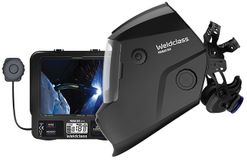Welding Helmet Troubleshooting Guide
Tips and tricks to help with electronic / auto-darkening welding helmet troubleshooting issues.
While this article is firstly intended to assist owners of Weldclass branded helmets, most of the tips suggested will apply to other brands too.
Top Tips
- Sensors: On the front of the auto-darkening lens are 2-4 sensors. These detect the welding arc and therefore need to have an unobstructed 'view', for the lens to operate.
- It is critical that front cover lenses are kept clean: If the cover lens is dirty or scratched, this will obstruct the sensors and the helmet cannot be expected to function correctly.
- Try increasing delay adjustment: This is not an obvious hack, but a very useful remedy once you understand how it works. Increasing delay time adjustment can help overcome 'intermittant failure to darken' issues. If there is a sensing disruption, a longer delay time will temporarily keep the lens 'locked' in dark mode until sensing recovers... and thus prevent the lens from switching light mode during this disruption.
Troubleshooting Checklist
|
Fault |
Possible Cause |
Applicable Weldclass Promax Helmet / Lens Model |
Possible Remedy |
| Intermittent failure to darken (sometimes does not switch to dark when welding starts) |
Momentary disruption to sensing of the arc |
All | Increase delay time adjustment Note: While the delay adjustment does not directly impact the sensors - if there is a momentary / brief sensing disruption, a longer delay time can 'lock' the lens in dark mode for sufficient time until sensing recovers proper detection of the arc. |
| Front cover lens is dirty or scratched and is obstructing the sensors | All | Replace front cover lens | |
| Sensitivity level is too low | All | Increase sensitivity level setting | |
| Sensors are dirty | All | Clean surface of the sensors with the corner of a tissue or soft cloth | |
|
Lens is staying dark when no welding arc is present |
Sensitivity too high |
All |
Reduce sensitivity level setting |
| Ambient light level is too bright | All | Reduce the ambient light level / other light sources | |
| Shade Lock is activated | 600, 650, 680, 850 | Shade Lock will lock the lens into dark mode. To unlock, press both UP & DOWN adjustment buttons together. See more info here. | |
| Lens will not switch/darken at all (no power / completely dead) | Grind mode is activated | 200, 350, 500, 600, 650, 680, 850 | Switch to weld mode |
| Batteries are discharged | 350, 500, 600, 650, 680, 850 | Replace batteries | |
| 100, 150, 180, 200 These models are solar-powered only, with non-removable rechargable battery |
Place helmet/lens in direct sunlight (with solar panel facing the sun) for at least 4 hours, longer if possible |
||
| Batteries not fitted correctly, or Battery or terminals are dirty | 350, 500, 600, 650, 680, 850 | Double check batteries are fitted correctly. Clean battery and/or terminals with soft dry cloth, if they are visibly dusty or dirty. | |
Why is My Welding Helmet Flickering
If your welding helmet is flickering this can be caused by a number of factors, such as low battery power, obstructed sensors, or incorrect settings. Review the checklist above to check potential causes.
Related Articles
User Guide for Promax 600 Series Helmets
View the Weldclass Helmet Range
-
This troubleshooting guide for welding helmets is incredibly helpful for both Weldclass branded helmets and other brands as well. The article provides valuable tips and tricks to address common issues that welders may encounter with their electronic/auto-darkening welding helmets. I appreciate the specific fault scenarios listed, along with the possible causes and suggested remedies for each. From momentary disruptions in sensing the arc to intermittent failure to darken, the article covers a range of troubleshooting situations. It's great to see that adjustments like delay time, sensitivity levels, and even cleaning the sensors can help resolve these issues. The guide also addresses more serious problems like the lens staying dark when no welding arc is present or when the helmet fails to switch/darken at all. The recommended solutions, such as adjusting sensitivity levels, reducing ambient light, and replacing batteries, are practical and easy to follow. The inclusion of the Weldclass Helmet Range and handy tools like the MIG Torch ID Guide and TIG Torch Selection Guide add further value to the article. Overall, this troubleshooting guide is a valuable resource for welders, providing practical solutions to address common issues with welding helmets. Weldclass continues to demonstrate their commitment to providing useful knowledge and support for the welding community. Rick Tillman rickyswelding.comDate: 02-08-2023Rickys Welding Equipment Rickys Welding






